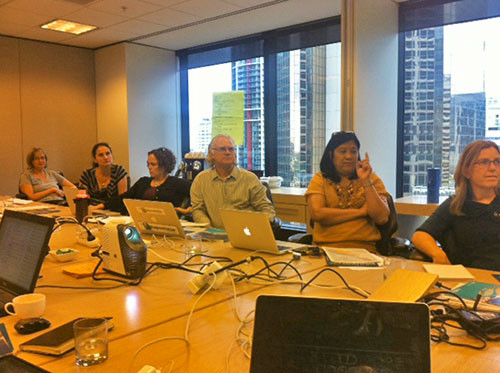Assessing the vulnerability of the Great Barrier Reef to climate change
Bill Dennison ·The Great Barrier Reef Foundation is an organization which funds research that protects and preserves the Great Barrier Reef, particularly in the face of climate change. The Foundation convened a workshop to develop a synthetic publication that charts the vision for assessing the vulnerability to climate change. The Great Barrier Reef components used in this assessment of climate impacts included coral reefs, seagrass meadows, mangrove forests and catchment runoff. A group of experts representing each of these components and Integration and Application Network staff gathered in downtown Brisbane, Australia to develop the storyboard design for this publication. The workshop attendees were Bill Dennison, Health Kelsey and Jane Thomas (Integration and Application Network), Eva Abal and Theresa Fyffe (Great Barrier Reef Foundation), Ove Hoegh-Guldberg (University of Queensland), Paul Marshall (Great Barrier Reef Marine Park Authority), Britta Schaffelke and Katharina Fabricius (Australian Institute of Marine Science), Norm Duke and Cath Collier (James Cook University). Claire Hanratty, Managing Director of the Great Barrier Reef Foundation provided an overview of the Foundation as well.

The Great Barrier Reef Foundation has an Attributes Working Group, chaired by Ove Hoegh-Guldberg, which has been developing a monitoring and evaluation framework for assessing impacts of climate change on the resilience of the Great Barrier Reef.

There are major climate impacts already being manifested on the Great Barrier Reef, including sea surface temperature induced coral bleaching, coral skeletal degradation due to ocean acidification and relative sea level rise leading to inundation of mangroves. Changes in runoff due to rainfall anomalies could also have profound implications for nearshore reefs, seagrasses and mangroves. The development of a climate vulnerability index would provide a probability-based assessment of the likelihood of damage due to climate, not unlike the fire danger threat levels.

The climate vulnerability index is designed to complement the Great Barrier Reef report card, which was developed to track the implementation of the Reef Plan through the Paddock to Reef program. The same six reporting regions will be used: Cape York, Wet Tropics, Burdekin, Mackay/Whitsunday, Fitzroy and Burnett/Mary regions.
About the author
Bill Dennison

Dr. Bill Dennison is a Professor of Marine Science and Vice President for Science Application at the University of Maryland Center for Environmental Science.

